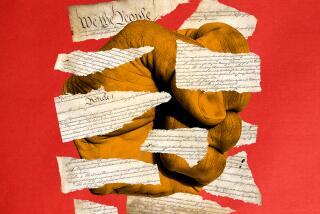Dancing With the Dictator
WASHINGTON — A little more than 50 years ago, the United States signed a pact with Generalissimo Francisco Franco allowing U.S. military forces to use air and naval bases in Spain. The agreement was a momentous event for Spain, and its repercussions still matter. For Americans, however, the pact, though significant, was a minor moment in the Cold War. U.S. historians barely mention it. The 50th anniversary passed in September with hardly any notice in Washington.
Yet, the event should not be overlooked, especially at a time when the president proclaims his commitment to whip up democracy throughout the Middle East. The pact is a bald and astonishing example of how easily the United States can abandon a commitment to freedom -- even one for which almost 300,000 American soldiers died during World War II. What counted more in 1953 -- and probably still does -- was stability and the U.S. perception of what is best for the United States in the short term.
The anniversary of the pact drew more notice in Spain, though the Spanish government stayed aloof from most associated events. There were a couple of academic symposiums, and newspaper columnists analyzed the pact’s history. But the most exciting product was the publication of a book, two months later, by noted Spanish historian Angel Vinas. “En las Garras del Aguila” (“In the Claws of the Eagle”) explores a half-century relationship between the United States and Spain by focusing on the original agreement for the bases and its periodic renewals.
The book is not an anti-American diatribe. Vinas is more troubled by Franco’s willingness to sacrifice Spanish sovereignty for a U.S. seal of approval on his regime. For an American, however, the U.S. betrayal of principle is far more shocking. It must have been dispiriting a half-century ago to watch Dwight D. Eisenhower, the supreme commander who had led the Allies to victory in World War II, embrace the pompous little tyrant Franco who had strode to power in the Spanish Civil War using weapons supplied by Adolf Hitler and Benito Mussolini.
After World War II, Franco was a pariah and an anachronism in Europe. Although Spain was officially neutral during the war, he did not hide his enthusiasm for Hitler. He even sent a division to fight alongside Nazi Germany against the Soviet Union. Spanish factories supplied gun barrels, rifle cartridges, uniforms and parachutes to the Germans. Spanish mines produced tungsten ore to help Germany turn out high-quality steel for armaments. Franco was such an admirer of Hitler that he insisted the Nazi leader had allowed the invasion of Normandy to trap Allied armies.
Although the Allies ruled out an invasion of Spain after the war, they agreed to apply diplomatic and economic pressure on the country in hopes of toppling the last of the fascists. As long as Franco ruled, said the U.S., Britain and France in a joint declaration, Spain would not enjoy full and cordial relations with them. A fascist and tyrannical Spain would have no place in Western Europe.
The United Nations denied Spain admission. The doors to the European Common Market and the North Atlantic Treaty Organization closed as well. The U.N. General Assembly urged members to withdraw their ambassadors from Madrid. When the United States launched the Marshall Plan to revive the economy of Europe, Spain was excluded.
The Franco regime was never more fragile. But it did not fall apart. The Cold War turned perceptions and pledges upside down. The Pentagon insisted it needed more bases to hem in the Soviet Union. Franco ruled a country that lay on the right spot. The United States signed the pact with Spain during the first year of the Eisenhower administration. In exchange for the bases, Franco received military assistance, some economic support and, most important, the implied moral backing of the United States. The clandestine democratic opposition in Spain was in despair.
The United States, which had cheered and assisted the flowering of democracy in defeated Germany and Italy, did no such thing in Spain. Franco once told a relative that the United States had never asked him to change any of his internal policies. “The understanding of the wily dictator was not mistaken,” Vinas writes. “As time went on, Washington became one of the stakeholders in the regime.”
The United States managed to ease Franco’s way into the U.N. During the dictator’s nearly four decades in power, no democratic European leader ever officially visited him. But presidents Eisenhower, Nixon and Ford did. “While Hitler helped Franco up in the first place,” Vinas writes, “it was the Americans who kept him on his pedestal.”
After Franco died in 1975 and Spain transformed itself into a democracy, Spanish leftists and other democrats who had chafed under his dictatorship were suspicious about U.S. intentions. Their wariness was exacerbated in 1981 when reactionary officers of the Civil Guard and army tried to overthrow the elected government. While democratic governments around the world condemned the unsuccessful coup attempt and voiced their support of King Juan Carlos and the new Spanish democracy, U.S. Secretary of State Alexander M. Haig Jr. maintained a foolish neutrality, describing the event in Spain as an “internal matter.” It sounded as if the Americans still hankered for Francoism. Haig’s fatuous remark, which had infuriated Spaniards of both the right and the left, damaged Spanish-American relations for several years.
The antipathy still emerges now and then. Although Prime Minister Jose Maria Aznar was one of President Bush’s staunchest supporters in the war against Iraq, his people were not behind him. Some of the largest and most vociferous demonstrations against the war erupted in Spain.
During the Cold War, the United States, despite all its high-minded rhetoric, embraced a tyrant -- and Franco was just one of many -- as long as he joined the crusade against communism. Is the United States, despite Bush’s high-minded rhetoric, ready to do the same as long as tyrants stand tall with us in the crusade against terrorism? The lesson of the pact seems clear.
More to Read
Sign up for our Book Club newsletter
Get the latest news, events and more from the Los Angeles Times Book Club, and help us get L.A. reading and talking.
You may occasionally receive promotional content from the Los Angeles Times.







